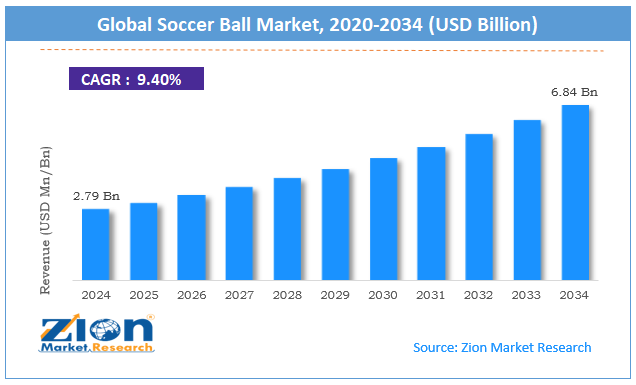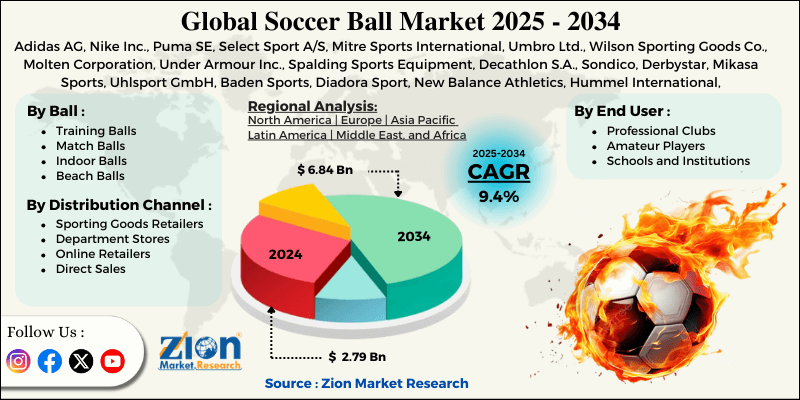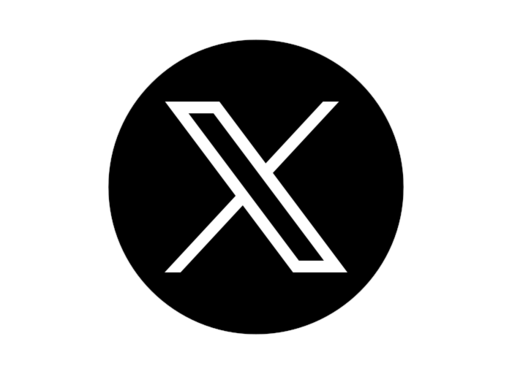Soccer Ball Market Size, Share, Trends, Growth and Forecast 2034

Soccer Ball Market By Ball Type (Training Balls, Match Balls, Indoor Balls, and Beach Balls), By Distribution Channel (Sporting Goods Retailers, Department Stores, Online Retailers, and Direct Sales), By End-User (Professional Clubs, Amateur Players, Schools and Institutions), and By Region - Global and Regional Industry Overview, Market Intelligence, Comprehensive Analysis, Historical Data, and Forecasts 2025 - 2034
| Market Size in 2024 | Market Forecast in 2034 | CAGR (in %) | Base Year |
|---|---|---|---|
| USD 2.79 Billion | USD 6.84 Billion | 9.40% | 2024 |
Soccer Ball Industry Prospective:
The global soccer ball market was valued at approximately USD 2.79 billion in 2024 and is expected to reach around USD 6.84 billion by 2034, growing at a compound annual growth rate (CAGR) of roughly 9.40% between 2025 and 2034.
Soccer Ball Market: Overview
Soccer balls are spherical sports equipment used in the game of soccer. They are typically made with a synthetic leather or polyurethane outer cover, stitched, or thermally bonded into panels with an inner rubber bladder that holds air to maintain shape and bounce. The market encompasses a range of products, from basic training balls to match-certified balls used in professional competitions.
Modern soccer balls have evolved significantly from their early leather counterparts and incorporate advanced synthetic materials, aerodynamic designs, and innovative bladder technologies that enhance performance, durability, and player experience.
The growing popularity of soccer, increasing participation across all demographics, and the rise of amateur leagues and youth development programs globally drive huge growth in the soccer ball market.
Furthermore, technological advancements in ball manufacturing, the expansion of e-commerce platforms for sports goods, and investment in sports infrastructure in emerging markets are significant opportunities for growth over the forecast period.
Key Insights:
- As per the analysis shared by our research analyst, the global soccer ball market is estimated to grow annually at a CAGR of around 9.40% over the forecast period (2025-2034)
- In terms of revenue, the global soccer ball market size was valued at around USD 2.79 billion in 2024 and is projected to reach USD 6.84 billion by 2034.
- The soccer ball market is projected to grow significantly due to the rising participation in soccer at both amateur and professional levels, increasing investments in sports infrastructure, and growing awareness about the importance of proper equipment.
- Based on ball type, match balls lead the segment and will continue to dominate the global market.
- Based on end users, amateur players represent the largest consumer segment.
- Based on the distribution channel, sporting goods retailers continue to lead sales.
- Based on region, Europe dominates the global market during the forecast period.
Soccer Ball Market: Growth Drivers
Growing global participation and professional league expansion
Soccer is growing globally, with participation increasing across all demographics and regions previously not considered soccer markets. Youth enrollment in soccer programs has substantially increased across North America and parts of Asia, creating a new demand for age-appropriate and skill-level-specific balls. Professional leagues are expanding into new territories with infrastructure investments and development programs requiring quality equipment in the soccer ball market.
Major international tournaments and high-profile club competitions have raised the profile of the sport and consumer interest in authentic professional-grade equipment. Research shows households with active soccer players buy new balls about twice a year, creating a steady replacement cycle that drives growth.
Technological advancements and product innovations
Manufacturing innovation is changing the soccer ball industry with advanced materials and construction techniques that improve performance characteristics during durability and player experience.
Leading manufacturers have introduced thermally bonded panels that reduce water absorption and maintain weight and shape during play. Smart sensor-embedded balls that track velocity, spin, and trajectory are gaining popularity among serious players and coaches looking to develop skills.
Eco-friendly manufacturing processes and sustainable materials are becoming differentiators as environmentally conscious consumers look for responsibly produced sporting goods. Advanced cushioning technology that reduces impact forces without compromising ball response has created premium segments for players looking for comfort and control.
Soccer Ball Market: Restraints
Counterfeit products and brand infringement
The soccer ball market is plagued by counterfeits that harm legitimate manufacturers and retailers and put consumers at risk of substandard products. Unauthorized copies of premium brand balls are widely available in the market, often at significantly lower prices that mislead consumers and affect the margins of authentic products. Industry investigations have found massive counterfeiting operations producing millions of fake branded soccer balls yearly.
Online marketplaces have accidentally enabled the distribution of counterfeits, making it hard for consumers to tell the real from the fake. Manufacturers are implementing anti-counterfeiting measures such as special packaging, authentication technologies, and supply chain tracking. Still, these added costs must be absorbed or passed on to the consumer.
Soccer Ball Market: Opportunities
Customization and personalization services
The growing demand for customized sporting equipment presents significant opportunities in the soccer ball market, with consumers and organizations increasingly seeking personalized products that reflect individual preferences or team identity.
Digital printing has made minor batch customization economically viable so that manufacturers can offer customized designs, colors, and graphics even for small orders. Team-specific customization has created new revenue streams for manufacturers and retailers who can now provide value-added services beyond standard products.
Custom balls are becoming popular as commemorative items for tournaments, special events, and corporate promotions, opening up non-traditional sales channels. Direct-to-consumer business models facilitated by e-commerce platforms have made personalization services more accessible to individual consumers and small organizations previously unable to meet minimum order requirements.
Soccer Ball Market: Challenges
Fluctuating raw material costs and supply chain vulnerabilities
Soccer ball manufacturers face mounting challenges from volatile raw material prices and increasing supply chain complexities that threaten production stability and price competitiveness. Synthetic leather and rubber compounds, the key components of modern soccer balls, are affected by petroleum price fluctuations.
Transportation disruptions have impacted global distribution networks, with manufacturers reporting longer lead times and fulfillment delays during peak seasons.
Labor costs in manufacturing regions are increasing and compressing margins, particularly in the mid-market, where price sensitivity is highest. Quality control issues can arise from supplier inconsistencies, especially for manufacturers who source components from multiple suppliers in different regions.
Soccer Ball Market: Report Scope
| Report Attributes | Report Details |
|---|---|
| Report Name | Soccer Ball Market |
| Market Size in 2024 | USD 2.79 Billion |
| Market Forecast in 2034 | USD 6.84 Billion |
| Growth Rate | CAGR of 9.40% |
| Number of Pages | 214 |
| Key Companies Covered | Adidas AG, Nike Inc., Puma SE, Select Sport A/S, Mitre Sports International, Umbro Ltd., Wilson Sporting Goods Co., Molten Corporation, Under Armour Inc., Spalding Sports Equipment, Decathlon S.A., Sondico, Derbystar, Mikasa Sports, Uhlsport GmbH, Baden Sports, Diadora Sport, New Balance Athletics, Hummel International, Joma Sport, and others. |
| Segments Covered | By Ball Type, By End User, By Distribution Channel, and By Region |
| Regions Covered | North America, Europe, Asia Pacific (APAC), Latin America, Middle East, and Africa (MEA) |
| Base Year | 2024 |
| Historical Year | 2019 to 2023 |
| Forecast Year | 2025 - 2034 |
| Customization Scope | Avail customized purchase options to meet your exact research needs. Request For Customization |
Soccer Ball Market: Segmentation
The global soccer ball market is segmented into ball type, end-user, distribution channel, and region.
Based on ball type, the market is segregated into training, match, indoor, and beach balls. Match balls lead the market due to their adherence to official specifications and high-performance characteristics.
Based on end-users, the soccer ball industry is divided into professional clubs, amateur players, and schools and institutions. Amateur players represent the largest segment due to the vast number of recreational participants worldwide, creating consistent demand for durable, affordable products.
Based on distribution channels, the soccer ball industry is categorized into sporting goods retailers, department stores, online retailers, and direct sales. Sporting goods retailers are expected to lead the market during the forecast period due to their specialized knowledge and the ability to offer hands-on product comparisons.
Soccer Ball Market: Regional Analysis
Europe to lead the market
Europe leads the soccer ball market, driven by the sport's deep cultural integration, extensive professional league structures, and robust youth development systems. Countries like Germany, Spain, the United Kingdom, and Italy feature extensive professional and grassroots club networks, creating consistent equipment demand.
European consumers demonstrate sophisticated product knowledge and a willingness to invest in quality equipment, supporting premium market segments. The region hosts major global competitions and boasts high per-capita spending on sporting goods, particularly soccer-related equipment.
Strong retail infrastructure in sporting goods provides effective distribution channels throughout the region. European manufacturers and brands hold significant global market share, with established reputations for quality and innovation that influence consumer preferences worldwide. Additionally, sustainability initiatives in European manufacturing are driving innovation in eco-friendly soccer ball materials and production processes.
Latin America is set to grow significantly.
Latin America is a growing region for the soccer ball market with a rich sporting heritage and improving economic conditions, which means more people have disposable income to spend on quality sporting goods.
Brazil, Argentina, and Mexico are the biggest consumers in the region, with high participation across all demographics and strong youth development programs. Improving economic conditions have expanded the middle class, which can buy higher-end products.
The region emotionally connects with the sport, driving brand loyalty, premium product adoption, and expanding retail infrastructure and e-commerce penetration to address historical distribution challenges in remote areas.
Domestic manufacturing is growing, reducing import dependence and creating more regionally relevant products. During major tournaments, sponsorships from international and regional brands also drive market visibility and product demand.
Recent Market Developments:
- In January 2025, Adidas launched an environmentally sustainable match ball featuring recycled ocean plastic and biodegradable materials while maintaining professional performance standards and official certifications.
- In February 2025, Nike introduced an integrated ball and digital training system combining sensor-equipped balls with smartphone applications that provide real-time performance feedback and skill development programs.
- In March 2025, Puma unveiled a revolutionary manufacturing process that reduces production waste by over 30% while improving panel alignment precision and consistent performance characteristics.
Soccer Ball Market: Competitive Analysis
Players lead the global soccer ball market like:
- Adidas AG
- Nike Inc.
- Puma SE
- Select Sport A/S
- Mitre Sports International
- Umbro Ltd.
- Wilson Sporting Goods Co.
- Molten Corporation
- Under Armour Inc.
- Spalding Sports Equipment
- Decathlon S.A.
- Sondico
- Derbystar
- Mikasa Sports
- Uhlsport GmbH
- Baden Sports
- Diadora Sport
- New Balance Athletics
- Hummel International
- Joma Sport
The global soccer ball market is segmented as follows:
By Ball Type
- Training Balls
- Match Balls
- Indoor Balls
- Beach Balls
By End User
- Professional Clubs
- Amateur Players
- Schools and Institutions
By Distribution Channel
- Sporting Goods Retailers
- Department Stores
- Online Retailers
- Direct Sales
By Region
- North America
- The U.S.
- Canada
- Europe
- France
- The UK
- Spain
- Germany
- Italy
- Rest of Europe
- Asia Pacific
- China
- Japan
- India
- South Korea
- Southeast Asia
- Rest of Asia Pacific
- Latin America
- Brazil
- Mexico
- Rest of Latin America
- Middle East & Africa
- GCC
- South Africa
- Rest of Middle East & Africa
Table Of Content
Methodology
FrequentlyAsked Questions
Soccer balls are spherical sports equipment used in the game of soccer. They are typically made with a synthetic leather or polyurethane outer cover, stitched, or thermally bonded into panels with an inner rubber bladder that holds air to maintain shape and bounce.
The soccer ball market is expected to be driven by increasing participation globally, technological innovations in ball design and manufacturing, growing youth development programs, expanding professional leagues in emerging markets, and rising consumer preference for premium, certified equipment.
According to our study, the global soccer ball market was worth around USD 2.79 billion in 2024 and is predicted to grow to around USD 6.84 billion by 2034.
The CAGR value of the soccer ball market is expected to be around 9.40% during 2025-2034.
The global soccer ball market will register the highest value in Europe during the forecast period, with Latin America showing the fastest growth rate.
Key players in the soccer ball market include Adidas AG, Nike Inc., Puma SE, Select Sport A/S, Mitre Sports International, Umbro Ltd., Wilson Sporting Goods Co., Molten Corporation, Under Armour Inc., Spalding Sports Equipment, Decathlon S.A., Sondico, Derbystar, Mikasa Sports, Uhlsport GmbH, Baden Sports, Diadora Sport, New Balance Athletics, Hummel International, and Joma Sport.
The report comprehensively analyzes the soccer ball market, including a detailed examination of market drivers, restraints, emerging trends, regional dynamics, and future growth opportunities. It also examines competitive dynamics, technological innovations, and the evolving consumer preferences shaping the soccer ball industry worldwide.
HappyClients
Zion Market Research
Tel: +1 (302) 444-0166
USA/Canada Toll Free No.+1 (855) 465-4651
3rd Floor,
Mrunal Paradise, Opp Maharaja Hotel,
Pimple Gurav, Pune 411061,
Maharashtra, India
Phone No +91 7768 006 007, +91 7768 006 008
US OFFICE NO +1 (302) 444-0166
US/CAN TOLL FREE +1 (855) 465-4651
Email: sales@zionmarketresearch.com
We have secured system to process your transaction.
Our support available to help you 24 hours a day, five days a week.
Monday - Friday: 9AM - 6PM
Saturday - Sunday: Closed







